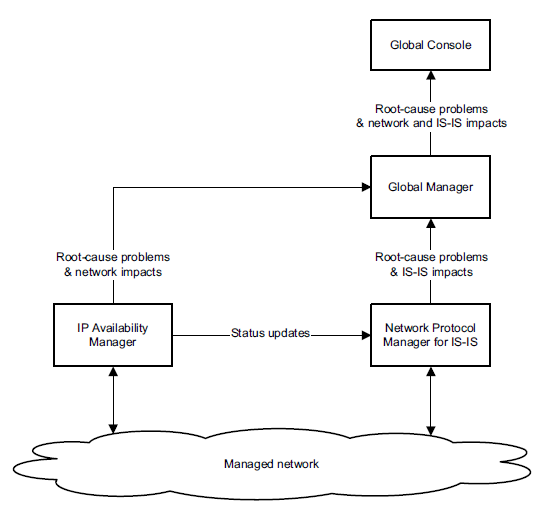IS-IS failures, or apparent failures, that are detected by Network Protocol Manager for IS-IS cannot be analyzed in isolation. Rather, those failures must be correlated with the physical-transport failures that are detected by IP Availability Manager in order to determine the root-cause problem that is underlying all observed symptoms. Network Protocol Manager for IS-IS analyzes IS-IS and physical-transport failures to determine whether an IS-IS failure is indeed a root-cause problem, or simply a symptom (impact) of an underlying physical-transport root-cause problem.
When Network Protocol Manager for IS-IS detects an IS-IS failure, it checks for any physical-transport problem that might be causing the failure. If it does not find such a problem, Network Protocol Manager for IS-IS focuses its analysis on just the IS-IS domain and performs the root-cause analysis described in Chapter 3, “IS-IS Objects and their Failures.”
If it does find such a problem, Network Protocol Manager for IS-IS diagnoses the IS-IS failure as an impact and exports the underlying physical-transport problem and the IS-IS failure to the Global Manager. The Global Manager responds by adding the IS-IS failure as an impact of the underlying physical-transport root-cause problem.
IS-IS and global impact analysis shows the flow of information between the components in a Network Protocol Manager for IS-IS deployment to achieve IS-IS and global impact analysis.

Status updates received from IP Availability Manager identifies the IP Availability Manager status updates to which Network Protocol Manager for IS-IS subscribes.
| Object |
Problem-type status |
Event-type status |
|---|---|---|
| 1**Indentation indicates class hierarchy. 2**Perceived as a problem-type status by Network Protocol Manager for IS-IS. |
||
| Card |
Down |
|
| NetworkAdapter Interface 1 Port |
Disabled, Down |
|
| NetworkConnection Cable 1 TrunkCable |
DownOrFlapping 2 |
|
| UnitaryComputerSystem Router 1 Switch and so on |
Unresponsive 2 |
|
Network Protocol Manager for IS-IS imports status information from IP Availability Manager through a remote (proxy) accessor, as shown in Remote accessor operation for Network Protocol Manager for IS-IS.

“Update object attributes” in Figure 17 corresponds to “Status updates” in IS-IS and global impact analysis and in Status updates received from IP Availability Manager. Status updates represent changes to problem-type and event-type instrumentation attribute values.
Adding IP Availability Manager as a source to Network Protocol Manager for IS-IS causes Network Protocol Manager for IS-IS to import topology and status from the IP Availability Manager. The Network Protocol Manager Discovery Guide Supplement provides the instructions for completing this task.